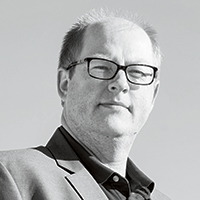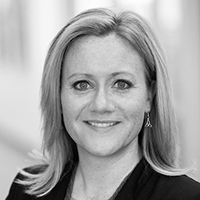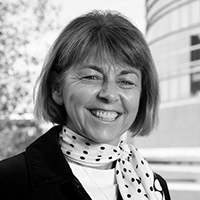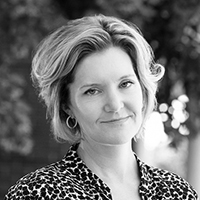
Dynamic Disruption
Tuesday, September 22, 2020
BY JOEL HOEKSTRA
Last spring, as the U pivoted to online instruction to help slow the spread of COVID-19, Carlson School instructors and students found themselves adjusting and adapting at warp speed. The results were insightful—and for some, invigorating.
Among Beth Campbell’s academic interests is the study of interpersonal dynamics and teams in the workplace. So, as you might expect, Campbell, an assistant professor of Work and Organizations, has taken a keen interest in how teams and worker interactions have changed amid the pandemic. When employees have to social distance or work from home, how does it affect productivity, morale, and business in general?
Campbell has been particularly interested in virtual onboarding. “What is the most effective way to embed someone in your company culture? We used to think it required workshops with bad muffins and coworker happy hours to get new employees to bond,” Campbell says. “But maybe that’s not necessary.” The jury is still out, she admits, but she’s working closely with a large Twin Cities professional services firm — she can’t disclose the name — to study onboarding practices that are effective in the current circumstances.
COVID-19 has not only reframed Campbell’s views of interpersonal interactions in the workplace, the pandemic has also made her more aware of communication in the classroom. “There are unexpected benefits to online learning,” she says. “I think it amplified the voices of less-vocal students. I heard some students contributing in a way that I couldn’t always hear when I’m in a 50-person lecture room.”
The experience has made Campbell look at challenges — in business, in teaching — with fresh eyes. “People initially dislike the virtual environment, but there are some advantages,” she says. “We need to look at the obstacles and think, Could parts of this be a feature, rather than a bug?”
Drawing the map
Professor and Marketing Department Chair Vlad Griskevicius compares the shift to online instruction at the University to the explorations of Sacagawea and Lewis and Clark in the American West. “There was no map,” he says. “You drew the map as you went along.” For some professors, it was exciting. For everyone, it was a challenge. “You had four days to figure it out,” Griskevicius notes.
The Carlson School faculty banded together in online discussion groups to consider solutions. “We had an immense amount of communication with each other and lots of cooperation,” Griskevicius says. But in the end, different people adopted different approaches — and some were more successful than others. The department polled students at the end of the semester to gain insights into what worked and what didn’t in online instruction. Griskevicius says the highest marks were given to instructors who took a hybrid approach, mixing short video lectures (“If it’s over seven minutes, it’s too long!”) with team activities and small-group discussions convened in virtual breakout rooms. “In this environment, students really appreciate discussion and being able to learn from each other,” Griskevicius says. “The art of teaching in Zoom is about asking really good questions.”
Griskevicius believes the pandemic experience has irrevocably altered online learning. “Most students — and their parents — are afraid of virtual learning because they’ve never had a good experience,” he says. “But once they see a well-designed experience, it radically alters how they look at education. There’s a belief that in-person instruction leads to a better outcome, but this experience is showing us that we can design a virtual class that’s also highly engaging, high-quality, and impactful.”
“In this environment, students really appreciate discussion and being able to learn from each other. The art of teaching in Zoom is about asking really good questions.”
The art of time traveling
Svjetlana Madzar teaches the capstone course for international business majors. A senior lecturer in Strategic Management and Entrepreneurship who has served on the guest faculty of educational institutions in France, Germany, India, and Spain — and has led students on international residency trips to Austria, Chile, Cuba, Hungary, and Peru, among other places — Madzar tries to impress upon her capstone students the specific challenges that arise when business goes global. “We focus on the strategic challenges of working across borders,” she says.
Madzar had just started teaching the capstone class when COVID-19 upended normal life around the planet. Her international students went home — to New Zealand, Spain, and Ukraine — and Madzar had to learn how to navigate time differences and technology issues as classes went online. Carlson School students returning from canceled study-abroad programs were allowed to join the class, and many had stories to tell related to the hardships of crossing borders. “The students had recent experience with the communication issues and challenges that pop up when you move from one country to another,” Madzar says. “In some sense, this was a real-time, real-life experiment.”
Dividing her students into teams, Madzar deliberately mixed one student in another time zone to each cohort. The result? Students had to learn to coordinate schedules and work through cultural misunderstandings at a distance, much as they would in global business.
Madzar believes that the global experience actually helped her students bridge differences and form emotional connections. “We realize that everyone is going through the same hardships,” she says. “In some sense, borders and cultural differences don’t matter. We’re all grappling with the virus.”
Teaching with Tiger King
PhD classes typically meet for multiple hours at a time each week, and when all University classes went online, Professor Kathleen Vohs approached hers with trepidation. “It was tough, really tough,” Vohs says. In the classroom, she explains, discussions move with a fluidity and lively energy that make them dynamic and interesting. She worried that holding them online would make the hours drag. “Three hours on Zoom is just a challenge for us all,” Vohs says. “It forced me to get really creative. I would sit on my kitchen table the morning before the class trying to figure out what I could do that would make it more fun.”
At one point during the term, Vohs asked the class to watch Tiger King, a popular Netflix documentary about the life of an eccentric zookeeper named Joe Exotic. Students may have thought the assignment was unusual, but Vohs connected the show to readings on consumer behavior. “We looked at the academic theories about human motivation and applied them to the show, which is an unbridled display of human ambition,” she says. “We also asked explored questions like, ‘Do people feel the same level of love for their pets as they do their children?’”
For many, the COVID era has diminished overall happiness, so Vohs asked her students to immerse themselves in literature about the topic. “I think we’re all realizing that we can derive meaning from small things,” Vohs says. “You don’t have to buy a Mercedes to be happy. Right now, we’re discovering that you can get meaning from small things, like just getting coffee at your local coffee shop.”
In the end, Vohs was impressed by her students’ willingness to stay on task. “I didn’t think I’d be able to expect much, given all the chaos,” Vohs says. “But my students were 100 percent right there.”
Wrestling with real-life problems
When people started fretting about shortages of toilet paper and hand sanitizer last spring with the onset of the COVID-19 pandemic, Professor Kingshuk Sinha took note. But he was confident that manufacturers would catch up with demand. He was more concerned, along with people in the medical community, about the worldwide supply shortage of PPE and ventilators, and the lack of capacity in hospitals and ICUs needed to care for the surging volume of COVID-19 patients.
“You want supply chains to be reliable, responsive, resilient, and responsibly managed,” Sinha says. “But as manufacturing has become more global, supply chains are more and more vulnerable to natural and manmade disasters. We’re seeing the effects of that right now.”
As the pandemic rewrote the rules of business and life around the world, Sinha reworked his spring semester graduate elective “Supply Chain Management in the Healthcare and Medical Device Sector” to focus specifically on the delivery of medical supplies and healthcare in COVID-19 times. “The problems we are facing now are not problems that we have ever faced before,” he says. “I felt it was important for students and me to wrestle with immediate real-life problems. The design and delivery of the course was occurring on the fly.”
“As manufacturing has become more global, supply chains are more and more vulnerable to natural and manmade disasters. We’re seeing the effects of that right now.”
His students rose to the occasion. One team developed their final course paper on the end-to-end supply chain for ventilators, taking into account the various stakeholders, challenges of affordability and coordination, stockpiling, and the role of government. Another team analyzed the COVID19 care supply chains of a large U.S. state, addressing issues related to PPE, hospital beds, plasma donations, racial disparity, mortuary capacity, and future vaccinations. “The students really immersed themselves in the problems and were creative in their solutions,” Sinha says. “We all learned something about health care and COVID—and gained some insight into what needs to happen to prepare for the future. It is the most live course I’ve ever taught.”






